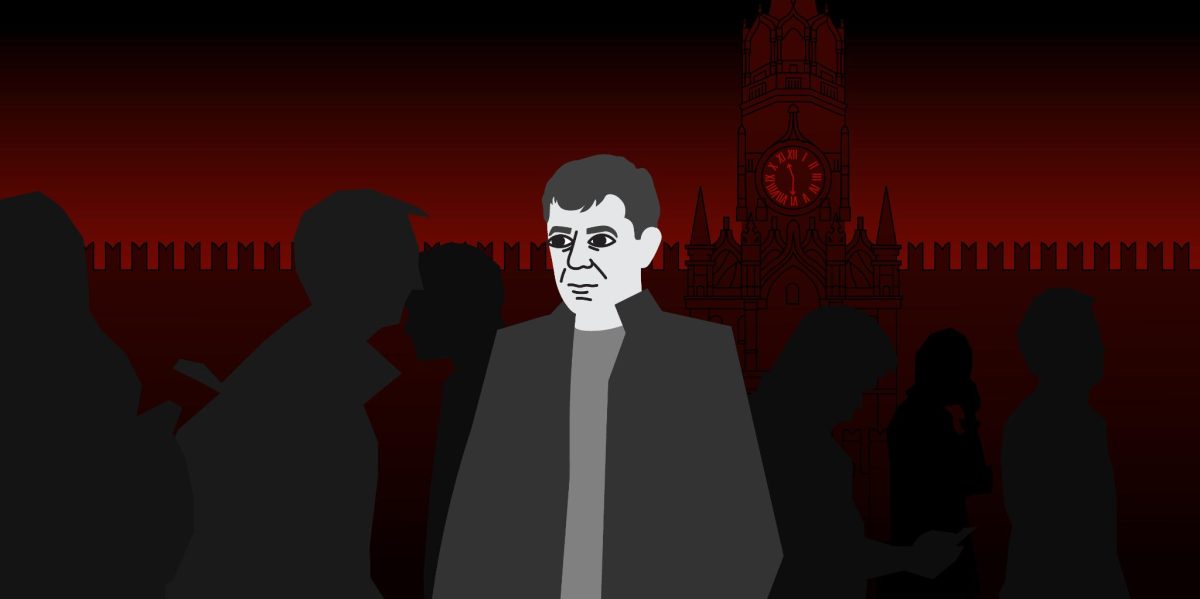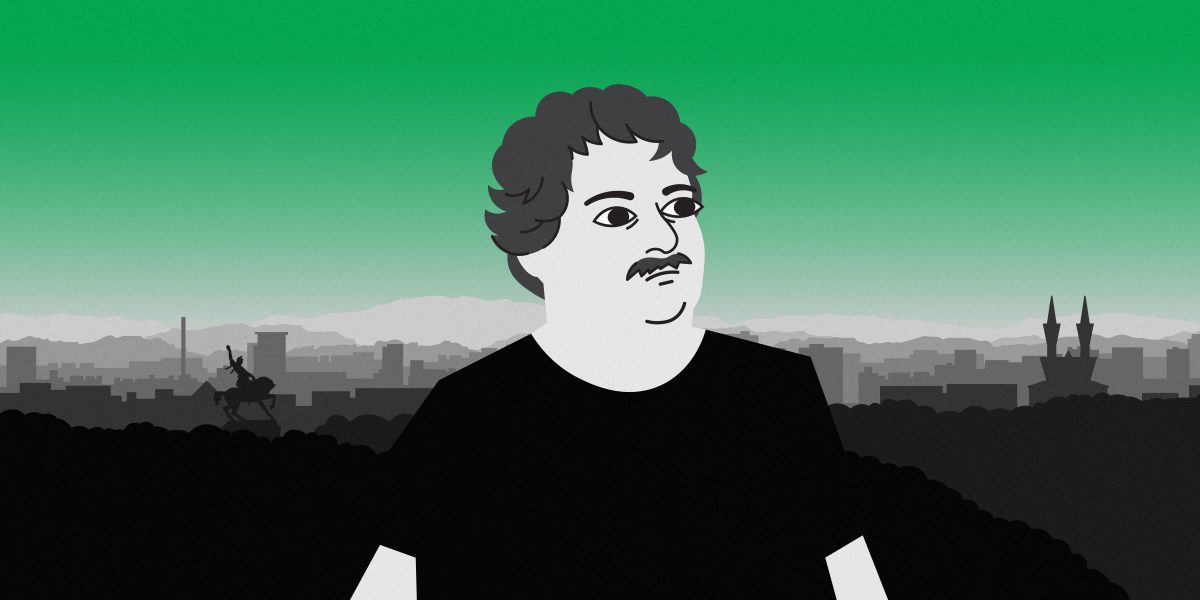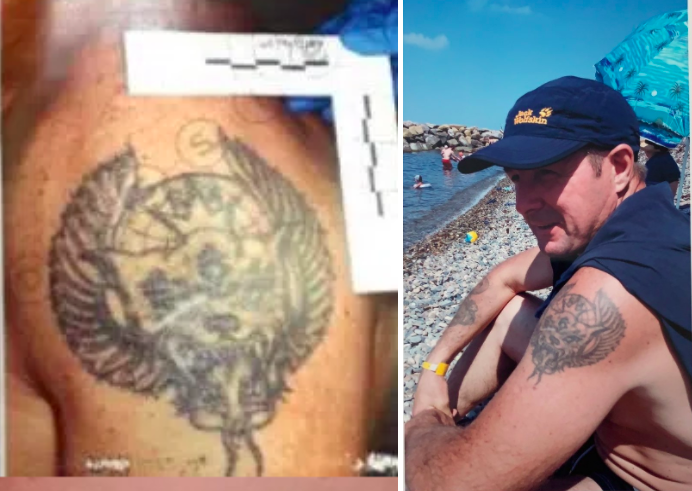Vladimir Kara-Murza Tailed by Members of FSB Squad Prior to Suspected Poisonings
- In a December 2020 investigation, we disclosed the existence of a clandestine unit within the FSB’s Criminalistics Institute, members of which – having medical and chemical weapons training – had closely tracked Alexey Navalny for years and had been near him during the hours before he was poisoned with a toxic substance of the Novichok type. Many of the officers in this unit communicated regularly with the Signal Scientific Center which a joint investigation linked to Russia’s chemical weapons program.
- A follow-up report presented an inadvertent admission by one of the unit’s chemical weapons specialists – Konstantin Kudryavtsev – who had been dispatched to Omsk following the poisoning to dispose of any traces of the toxic substance on Alexey Navalny’s personal items.
- A third report from the series identified three victims – a journalist, a minority rights activist and an anti-corruption activist – who had died under suspicious circumstances between 2014 and 2019. We traced members of the FSB poison squad to near these individuals in the period preceding their deaths in all three cases. In this report we also identified the role of the FSB’s Directorate for Protection of the Constitutional Order in preparing and conducting poisoning operations.
In this new report, prepared jointly with The Insider (Russia) and Der Spiegel (Germany), we investigate the possible role of the two FSB units in two near-fatal poisonings of Russian politician and opposition activist Vladimir Kara-Murza.
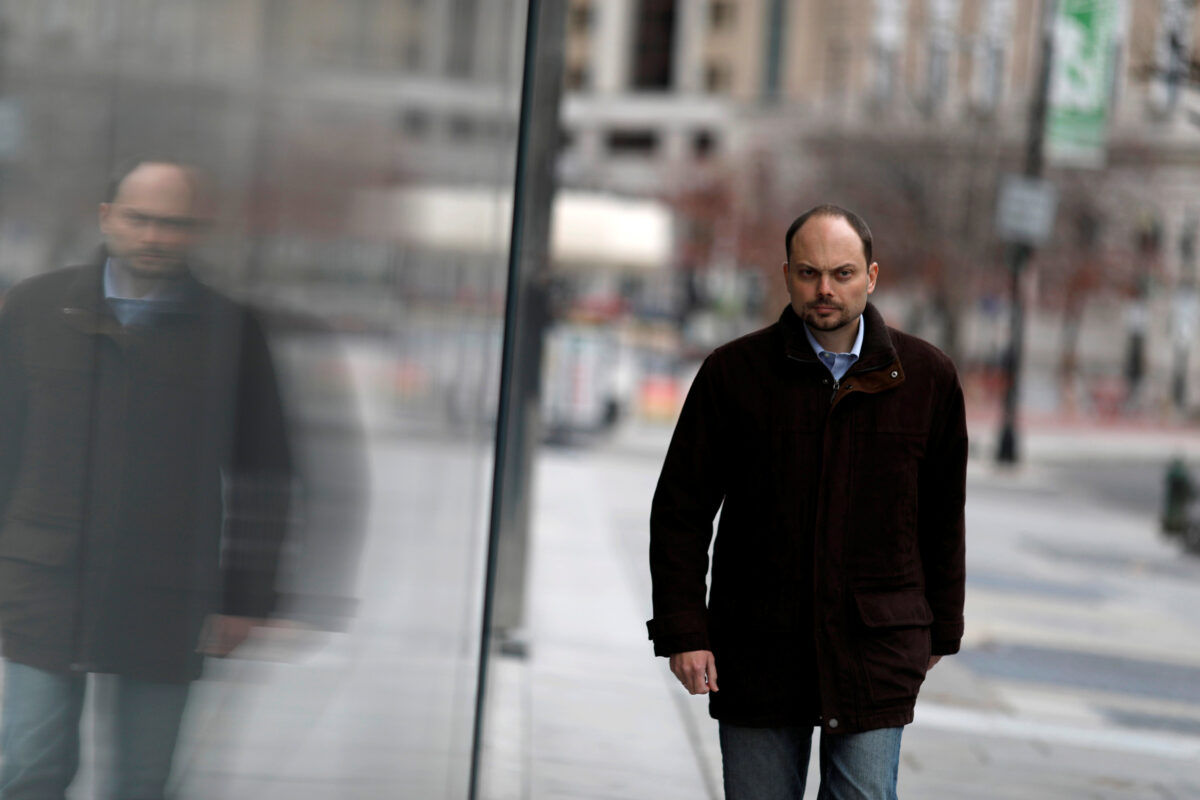
Vladimir Kara-Murza arrives for an interview at the offices of Reuters in Washington, D.C., USA, March 13, 2017. Photo (c): Reuters/Aaron P. Bernstein
In May 2015 and February 2017, Vladimir Kara-Murza, a well-known Russian politician, filmmaker and an outspoken critic of the Russian president Vladimir Putin, suffered two similar near-fatal medical emergencies. Both left him in a prolonged coma with severe shutdown of his vital functions. Despite Kara-Murza’s suspicions of being poisoned as retaliation for his political activities, Russian authorities refused to initiate criminal proceedings into either case. Two Russian hospital reports and three international examinations have concluded that the incidents were caused by intoxication with an unidentified substance. The exact cause and source of the poisonings has remained a mystery.
Based on an analysis of travel records of known members of the poison squad from the FSB’s Criminalistics Institute previously implicated in the poisoning of Alexey Navalny and three other Russian activists, we have now established that this unit also systematically tailed Vladimir Kara-Murza before both his first and second medical emergencies. Crucially, members of this FSB unit had shadowed Kara-Murza on a campaign trip outside Moscow that ended less than 48 hours before his first poisoning incident. The FSB unit then resumed following Kara-Murza approximately five months after he returned from treatment in the USA. The same team would continue tailing him until he was poisoned for the second time on 1 February 2017.
The number of coinciding trips – seven destinations with fourteen overlapping flights – renders a coincidental overlap statistically implausible. Kara-Murza’s public profile, and the manner in which he was systemically tailed, also bears striking similarities with this FSB unit’s other known assasination operations.
One crucial finding of this investigation is that on at least one tailing operation – just two months before Kara-Murza’s first poisoning in May 2015 – members of the FSB poison squad were accompanied by a senior official from the FSB’s 2nd Service – better known as the “Directorate for Protection of the Constitution and the Fight against Terorism”. This officer, Roman Mezentsev, has previously traveled on joint bookings with high-level Kremlin officials including Vladislav Surkov, President Putin’s former advisor nicknamed The Grey Cardinal for his powerful backroom role in Kremlin politics.
Another potentially relevant finding in this report is that we have tracked the earliest incident of tailing of Vladimir Kara-Murza by the FSB’s poisoning unit to just several days before the assassination of Boris Nemtsov on a bridge near Red Square in Moscow. This temporal overlap paired with the similarity in risk profile of the two political activists – both were outspoken critics of the Russian president, founding members of a united opposition initiative, and initiators of the Magnitsky Act – raises renewed questions about whether the Russian security services may have known or had a role in Nemtsov’s assassination (although Nemtsov was murdered by firearm, we had previously established that the FSB was also behind the murder of Zelimkhan Khangoshvili, who was shot dead in Berlin in August 2019).
Who is Vladimir Kara-Murza?
Vladimir Kara-Murza is one of Russia’s leading opposition figures. Starting his career in journalism at the age of 16, by the time he was 18 he was already a parliamentary aide to Boris Nemtsov, with whom he collaborated until Nemtsov’s murder in 2015.
Kara-Murza played a crucial role in the lobbying and implementation of the Magnitsky Act which allows the US government to freeze assets of Rusisian and other government officials deemed to be human rights offenders, which was a thorn in the side of the Russian leadership. Between 2004 and 2012, Kara-Murza worked as Washington bureau chief of a Russian independent TV station, RTVI.
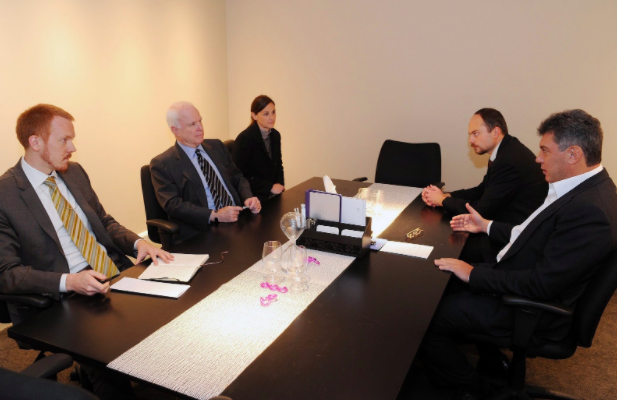
Russian opposition leader Boris Nemtsov and Vladimir Kara-Murza at a meeting with U.S. Senator John McCain in Washington D.C. to discuss the Magnitsky Act, 15 November 2010. McCain would become the co-sponsor of the Magnitsky Act introduced in the Senate in May 2011. Photo courtesy of Vladimir Kara-Murza
Following the station’s change of ownership in 2012, he became senior policy advisor to the New York-based Institute of Modern Russia, and as of 2014 accepted a role as the Russian national coordinator for Open Russia – a political movement founded by former oligarch Mikhail Khodorkovsky. In this role, he split his time between Russia and the United States where his wife and three children live.
The 2015 Poisoning
In early 2015, Kara-Murza had been traveling to several destinations in Russia as part of his work for the Open Russia movement. On 22 May 2015 he flew to Kazan, the capital of Tatarstan, for a public lecture organized by the movement. He returned to Moscow on the evening of 24 May 2015. The next day was uneventful, with several work meetings with other politicians and late dinner with his father at a restaurant.
Two depositions filed with Russian investigators by Kara-Murza which he shared with us, alongside his own recollections, shed detailed light on what transpired during and after his poisoning. On the following day, 26 May, he skipped breakfast and went straight to Bobry i Utki restaurant for a business lunch with a colleague from the Parnas opposition party. He had food from the buffet table and ordered a cranberry juice on the side. Kara-Murza had no other food that day.
From the restaurant, he went straight to a meeting at RIA Novosti, Russia’s state-owned news agency. The meeting, with Oleg Efrosinin, the chief of a RIA Novosti subsidiary, and Kara-Murza’s Open Russia associate Mikhail Yastrubitsky, started at 14:30. Approximately an hour into the meeting, Kara-Murza suddenly experienced difficulty breathing, heavy perspiration, extremely low blood pressure, and a starkly accelerated pulse, followed by uncontrollable bouts of vomiting.
“In a few minutes I suddenly fell ill”, he recalls. “I could feel my pulse, had difficulty breathing, sweat, and wanted to vomit. I went to the toilet, then returned to the meeting leaning against the wall. My colleagues put me on a sofa and called the ambulance. Literally in 10 to 15 minutes, I went from a perfectly healthy individual to a goner.”
One of the witnesses, Yastrubitsky, later told the media that Kara-Murza was “rather frail [and] speaking slowly. In fact, he could no longer move his arms and legs. His eyes kept closing, and we were talking to him constantly, so he would not lose consciousness.”
Kara-Murza passed out in the conference room, and the ambulance took him to the Davidovsky clinic 45 minutes later. He was initially diagnosed with heart failure and was transported, unconscious, to a specialized cardiovascular clinic for immediate cardiac surgery. Doctors at the clinic, however, reached a different conclusion: his condition was not caused by heart failure but by acute poisoning with an unknown substance. Based on this new diagnosis he was moved once again to the intensive care unit of the reputable Pirogov hospital.
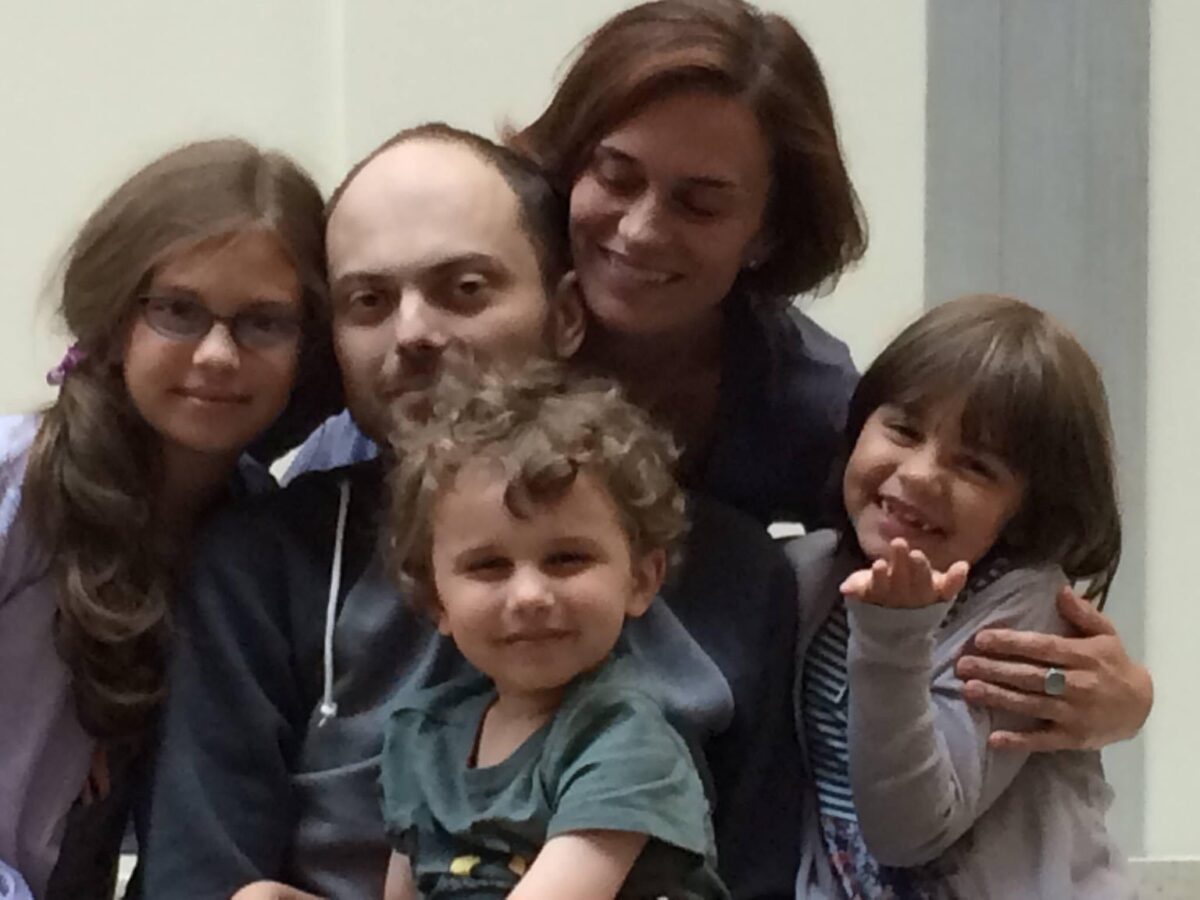
Kara-Murza with his family, shortly after he was transported to the US for rehabilitation in July 2015. Photo courtesy of Vladimir Kara-Murza
Shortly thereafter, Kara-Murza experienced multiple organ failure and collapsed into a coma. In its official explanation, the hospital stated that the intoxication had been caused by citalopram, an antidepressant that Kara-Murza had been taking, ostensibly ignoring the fact that he had taken the same dosage for several years without problems.
At risk of organ failure, Vladimir Kara-Murza was placed on life support and remained in a coma until June 2. When Kara-Murza’s wife, Evgeniya, arrived in Moscow on 29 May the doctors told her that her husband’s chances for survival were around five percent. Hereafter, events took a course now reminiscent of that which followed Alexey Navalny’s 2020 poisoning. The chief medic of First Moscow Clinic, Alexey Svet, stated that the patient was “non-transportable” abroad, therefore could not be moved to Germany for treatment.
Nevertheless, on the same day as Evgeniya’s arrival, samples of Kara-Murza’s blood, urine and hair were shipped for toxicology analysis to a French laboratory. The lab found that there had not been an overdose of citalopram, however the concentration of manganese in Kara-Murza’s blood was 100 times over the limit. Zinc and copper were also significantly above normal levels, while iron was below the norm.
Kara-Murza’s condition gradually improved and he was released from Pirogov hospital a month later, on 4 July 2015. Still largely immobile, he was immediately flown on an ambulance plane to the United States to continue his treatment and recuperation there.
In December 2015 Kara-Murza submitted a criminal complaint to Russia’s investigative authorities, in which he stated that he suspected he had been poisoned due to his opposition political activity. He was initially questioned but the authorities never informed him as to whether a criminal investigation into the poisoning was opened.
Tailed by the Poison Squad in 2015
Our previous investigations of poisonings attributable to the FSB’s Criminalistics Institute focused on cases where the attempts were made outside Moscow. On one hand, it is easier to link a previously unexplained poisoning incident to the presence of the FSB poison squad to a location outside of their normal place of residence and work. On the other hand, the cases concerning Alexey Navalny and Nikita Isaev may indicate that this squad has a preference for operations while the target is traveling in the provinces. If so, this may be either because of the assumed inferior quality of emergency medical services in those regions; due to the relative ease of accessing a target’s hotel room during trips; or even due to expected long-haul trips by their targets during which medical care would be impeded.
As a result, investigating poisonings that took place in Moscow presents a unique challenge, especially when they occurred years in the past and telephone geolocation records can no longer be obtained from sources with access to logs of Russian mobile operators which store metadata for a maximum of three years. However, the observed preference of the FSB squad for “out-of-Moscow” poisonings can be used as a proxy for determining their likely complicity to Moscow-based operations as well. It can be logically assumed – and is corroborated by data in the Navalny and Isaev cases – that the squad typically tails a target of a political assassination for at least several months before a hit is launched.
With this hypothesis, we analyzed trips made by Vladimir Kara-Murza in the 12 months prior to his 2015 poisoning, and compared them to trips made by known members of the FSB Criminalistics Institute and officers of the FSB’s 2nd Service (constitutional-order protection) who have previously been identified as traveling on joint bookings with members of the poison squad.
We discovered that in the three months prior to his unexplained poisoning, Vladimir Kara-Murza had been tailed by the FSB during at least four trips he made out of Moscow. These were trips to Tomsk, Saint Petersburg, Kaliningrad and Kazan. Crucially, the trip to Kazan had taken place from 22 to 24 May 2015 – with Kara-Murza and his FSB fellow passengers returning to Moscow less than 48 hours before his symptoms began.

The one name connecting all four tailing trips is that of Alexander Samofal – an FSB officer who frequently traveled on joint trips with members of the poison squad. There is a scant digital fingerprint for this person. A leaked 2006 driver’s license database lists his address as “military unit 2567”, which corresponds to the FSB border service academy in Golitsyno near Moscow.
Based on his circle of contacts visible from his phone interactions, it is safe to assume that after graduating the academy, Samofal joined the FSB’s 2nd Service (constitutional-order protection), and was periodically seconded to work with members of the poison squad. As disclosed in our previous investigation, Samofal traveled together with Dr. Alexey Alexandrov of the poison squad to tail the Russian anti-corruption activist Nikita Isaev just before he died on a train ride between Tambov and Moscow in 2019. On at least two trips shadowing Kara-Murza, Samofal was joined by Konstantin Kudryavtsev, the chemical weapons specialist who in December 2020 inadvertently confessed to having been in charge of evidence destruction in the Navalny poisoning case.
Based on available travel data and on known names of FSB operatives, the first trip on which Kara-Murza was tailed by the FSB was a flight to the Siberian city of Tomsk which he visited from 25 to 27 February 2015. In keeping with the poison squad’s routine, Samofal and his colleagues did not take the same flights that Kara-Murza did, but flew just before him in both directions – landing in Tomsk on the evening of 24 February and leaving for Moscow in the small hours of 27 February.
The timing of this maiden shadow trip is notable in that it took place only three days before the killing of Boris Nemtsov, Kara-Murza’s mentor and collaborator in lobbying for the Magnitsky Act. Nemtsov was killed within an earshot of the Kremlin just before midnight on 27 February; the FSB team had returned from Tomsk earlier that day. There is no data that links the FSB to Nemtsov’s murder, in which only the alleged perpetrators were convicted for a contract killing but neither the motive was identifed nor the person(s) allegedly contracting the murder were ever prosecuted.
Following Nemtsov’s murder, the tailing operations against Kara-Murza did not abate, with two shadowing trips in March alone. The FSB squad followed him by train to St. Petersburg and back between 20 and 22 March 2015 – again taking a train a day earlier and returning on the same day as Kara-Murza. During this trip, authorities prevented Kara-Murza and the political strategist and analyst Stanislav Belkovsky from holding a public lecture organized by Open Russia.
Just three days later, on 25 March 2015 Kara-Murza traveled to Kaliningrad, returning on 27 March. A group of at least three FSB officers followed suit on a different flight. These were Alexander Samofal, Konstantin Kudryavtsev, and Roman Mezentsev, the senior officer from the FSB’s 2nd Service.

Flight record showing Samofalov, Mezentsev and Kudravtsev’s presence on a flight from Moscow to Kaliningrad on 26 March 2015
Roman Mezentsev is the highest-ranking FSB officer we have identified on any tailing trip linked to an FSB poison squad operation. Mezentsev has worked for the FSB since at least 2005; that year, he is named on its website as a security services official in Ingushetia, in Russia’s North Caucasus, where an armed insurgency was underway.

Photo from the driver’s license of FSB officer Roman Mezentsev
An analysis of his phone calls, obtained by us from two unrelated data brokers from Russia’s black market in data, as well as of historical flight data, shows that Mezentsev interacted daily and frequently traveled with the chief of the directorate of the 2nd Service, Alexey Zhalo, and with other high-ranking FSB and government officials. For instance, in September 2014 he flew to Uzbekistan together with the two closest deputies to the Director of the FSB Alexander Bortnikov, namely Gen. Sergey Smirnov and Gen. Alexey Chekhovskikh. Sergey Smirnov was Bortnikov’s First Deputy, and oversaw the 2nd Service until October 2020 when he retired.

Flight record showing the presence Roman Mezentsev, Alexey Chekovskikh, Sergey Smirnov and Alexey Zhalo on a flight from Moscow and Uzbekistan’s capital Tashkent on 19 September 2014, returning three days later
Mezentsev traveled three times to Kyiv as part of an FSB delegation in the company of Zhalo and FSB’s deputy director Smirnov at the height of the stand-off between Ukraine’s security services and pro-European protesters in December 2013 and early 2014. During one of the trips, on 20 February 2014, Mezentsev flew as part of a delegation that included Vladislav Surkov, then advisor to Vladimir Putin, and Sergey Beseda, the head of the FSB’s 5th (International) Service.

Left: Reverse phone-search listing for Mezentsev’s number showing him as working for the Directorate for the Defense of Constitutional Order (by its Russian acronym УЗКС). Right: Residential database listing showing Mezentsev as residing at a corporate residence at Lubyanka 1 – the address of the headquarters of the FSB
Mezentsev’s recent phone records also show that he communicated with scientist Col. Makshakov, the deputy chief of the FSB’s Criminalistics Institute and de facto chief of the FSB’s poisoning program. The pattern of communication between Mezentsev and Makshakov (after incoming calls from Mezentsev, Makshakov proceeded to call members of the poison squad – Osipov and Alexandrov, and then returned calls to Mezentsev) suggests that Mezentsev was the liaison officer of the 2nd Service supervising these poisoning operations. This pattern was most recently observed on 27 July 2020, just days before the Navalny poisoning operation in Tomsk was initiated.
The fourth tailing trip in 2015 ended just two days before Kara-Murza’s first severe poisoning. At least two FSB officers – Alexander Samofal from the FSB’s 2nd Service and Valery Sukharev from the Criminalistics Institute – shadowed him during a trip to Kazan between 22 and 24 May 2015. This lecture trip, like the previous visit to St. Petersburg, appeared to be sabotaged by authorities, and on 23 May 2015 Vladimir Kara-Murza tweeted that his telephone – as well as those of the Kazan lecture organizers – were out of service.

“Friends, please accept my apologies if you’ve been unable to reach me: my telephone and that of the organizers of Zubov’s lecture in Kazan are still blocked” reads this second Tweet by Vladimir Kara-Murza
Based on his phone records and digital footprint from leaked databases, Valery Sukharev, born in 1956, appears to be one of the senior-most operatives of the Criminalistics Institute’s poison squad. In the period surrounding Alexey Navalny’s poisoning in Tomsk (between 10 and 25 August 2020), Sukharev exchanged over 100 calls with members of the squad, primarily with Oleg Tayakin (47 calls and/or text messages) who, as reported earlier, coordinated the poisoning operations from Moscow (and gained fame by shutting the door on a CNN reporter who attempted to confront him about it). He also communicated with Makshakov (11 times) and dozens of times with Alexandrov, Osipov and Kudryavtsev. A Moscow residential database shows that as of 2008 he was entitled to special benefits that are typically associated with a government or military award. The only other member of the poison squad having such benefits is Ivan Osipov.
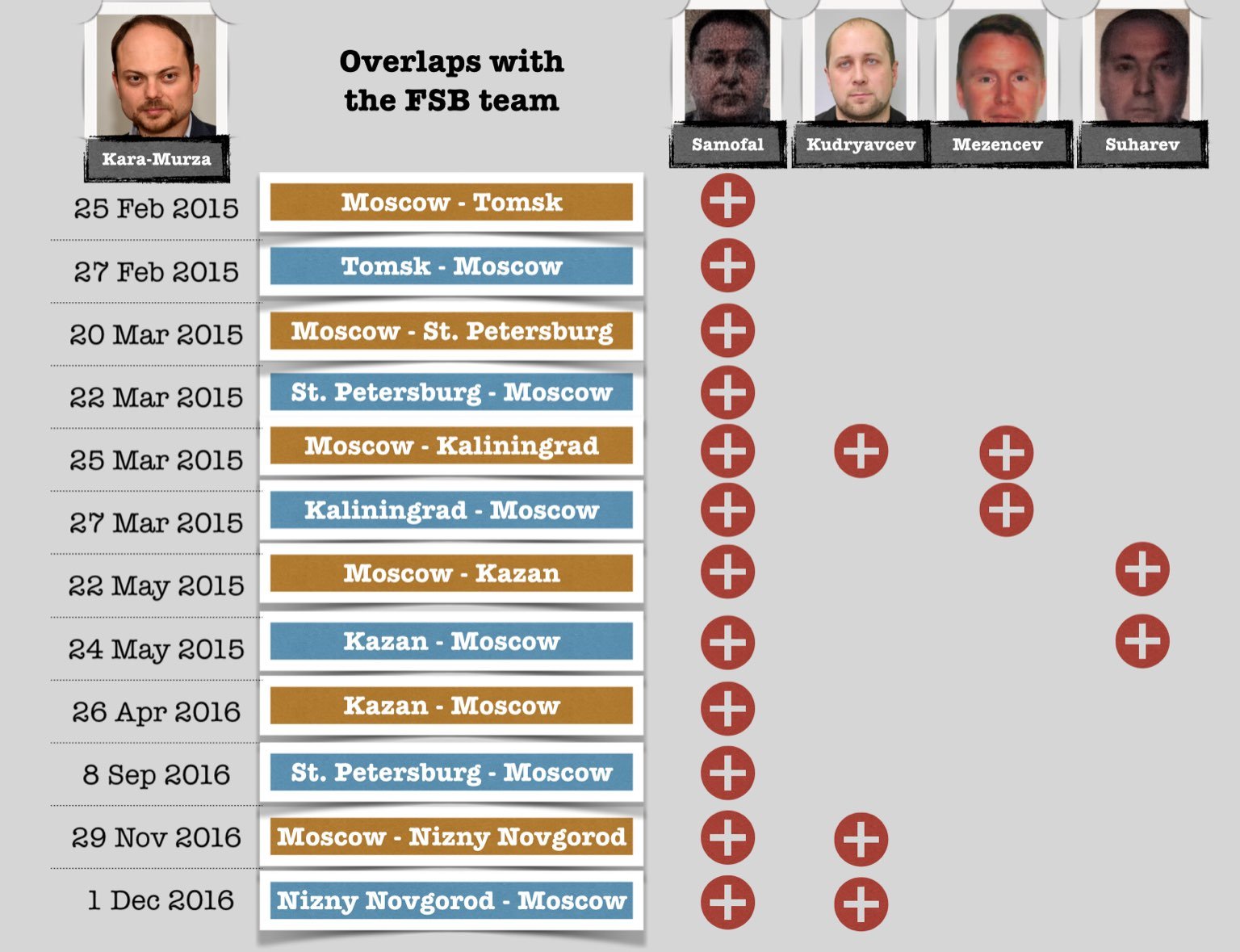
The overlapping travel history of Vladimir Kara-Murza and his known FSB followers. Infographic by Bellingcat
Due to the long time elapsed since 2015, geolocated telephone data for members of the squad is no longer available, thus it does not appear possible to trace their movement within Moscow in the short interval between Kara-Murza’s return from Kazan and the moment he succumbed to the poisoning.
On the assumption that the FSB unit, including known members of the poison squad, that traced Kara-Murza through 24 May 2015 was linked to his poisoning on 26 May 2015, two possible hypotheses emerge. In one, the unit – having failed to find an opportune moment during the Kazan or any of the previous trips – had chosen to administer the toxin in Moscow, either by breaking into the apartment where Kara-Murza lived alone and applying it onto a personal item; or by mixing it into food or drink he had consumed on the day he fell ill (for instance at the buffet restaurant). A second hypothesis is that the FSB unit had administered the poison onto Kara-Murza’s packed clothes in his hotel room in Kazan – but that he had not used the contaminated piece of clothing during the trip, and had instead put it on upon arrival in Moscow. The latter tallies with repeated statements by Vladimir Uglev, one of the developers of Novichok, that underwear would have been the most plausible administration method, as well as with the existing evidence that Navalny had been poisoned in this way. In talking to us, Vladimir Kara-Murza did not exclude the latter possibility, saying he would often pack a surplus of clothes when going on a trip.
Tailed Again, Poisoned Again
Despite rehabilitation in the US, Kara-Murza did not fully recover from his first poisoning. He walked with a cane for more than a year and had persisting issues with the peripheral nervous system. In December 2015, he decided to return to Russia to continue his work for Open Russia. Due to his impaired mobility – he had to walk using a cane for over a year after the poisoning – Vladimir could not resume travel throughout Russia until months later. In April 2016, Kara-Murza made his first two work trips after his recovery: the first to the Siberian city of Irkutsk (13 to 16 April), and the second to two cities in Tatarstan: Naberezhnye Chelny (24 April) and Kazan (25 and 26 April). During the second trip, he was unknowingly reunited with his old FSB “groupies”: Alexander Samofal and Valery Sukharev. Samofal flew into Kazan from Ekaterinburg, and Sukharev flew from airports in Moscow to Kazan, both on 25 April, just before Kara-Murza would arrive there. They left for Moscow on 26 April, several hours before Kara-Murza’s flight.
The Tweet below shows Kara-Murza on Bauman Street in the center of Kazan that same day, alongside two opposition candidates for Duma elections:
В Татарстане у «Открытой России» сразу два кандидата в ГД – @ilyavnovikov и @mingalimovrg Настроены по-боевому 🙂 pic.twitter.com/xMESCol3y5
— Vladimir Kara-Murza (@vkaramurza) April 26, 2016
The next time he was shadowed by FSB officers was during his trip to St. Petersburg on 8 September 2016. On that day he had a scheduled court trial over holding an “unauthorized rally”, and risked being jailed in the city for 15 days, as emanded by the police. The judge threw out the case and he could return the same day. Six days before the court date, Alexander Samofal had arrived in St. Petersburg. He left back to Moscow on 8 September, on the same day as Vladimir Kara-Murza.
The last overlap between members of the poison squad and Kara-Murza’s travels in 2016 was during his trip to Nizhny Novgorod where he would premiere his film in memory of the slain Boris Nemtsov between 29 November and 1 December 2016. On 29 November, using a train in lieu of a plane, Alexander Samofal and Konstantin Kudryavtsev also arrived at Nizhny Novgorod. They both left by train on 1 December 2016, just two hours before Kara-Murza took a train back to Moscow.
We have not identified further overlapping trips between Kara-Murza and members of the poison squad until his second poisoning, which took place in Moscow two months after the last known joint trip to Nizhny Novgorod, on the night of 1 to 2 February 2017.
On the previous day, 31 January, Kara-Murza had taken a day-trip by train to Tver, about three hours north-west of Moscow, where he showcased the Nemtsov film. He returned to Moscow late that night and spent the night at his empty apartment.
According to his deposition to Russia’s investigative authorities, on the next day – 1 February 2017 – Kara-Murza visited the mayor’s office just before noon to file a request for permission to hold a public march in memory of Boris Nemtsov’s death anniversary later that month, and then then walked over to the Aeroflot central office.
At about 3 pm he had lunch at the Ruccola cafe with an activist from the liberal opposition party Yabloko, and then went home to pack his luggage. On the following day, 2 February, he would be flying to Washington to attend his younger daughter’s birthday. He then got a taxi to his parents-in-law where he would spend the night. In the morning he would be flying to the US together with his mother-in-law.
Kara-Murza went to bed at around midnight, but at around 4 am he woke up in a panic. He felt – in his words – exactly the same symptoms as he had experienced just under two years earlier: an accelerated heartbeat, very low blood pressure and difficulty breathing. Before he passed out, Kara-Murza was able to wake up his in-laws and call his wife. She called Dr. Denis Protsenko – the same doctor who treated her husband at the Pirogov hospital during his 2015 poisoning. Dr. Protsnko was now chief surgeon at the Yudina General Hospital and quickly arranged for the barely conscious Kara-Murza to be transported to that clinic. The medics noted a complete match between Kara-Murza’s symptoms at the time and those observed during the previous hospitalization. They promptly diagnosed him with “severe intoxication with an unknown substance”.

Kara-Murza, in intensive care at Yudin Hospital shortly after being awakened from a coma. On the left is his wife Evgeniya Kara-Murza, on the right are his lawyer Vadim Prokhorov and journalist Alexander Podrabinek. Photo courtesy of Vladimir Kara-Murza
Over the next several hours, the doctors observed progressing respiratory and kidney function failure. Kara-Murza was initially intubated after which the doctors conducted a tracheostomy and a blood plasma replacement procedure, and ultimately placed him into an induced coma with external respiratory support. Six days later, on 8 February 2017 he was awakened and removed from ventilator support. On 19 February he was deemed healthy enough to be transported to the US for further treatment and rehabilitation.
A Redacted FBI Investigation
After Kara-Murza regained consciousness, a toxicology report was commissioned from Russia’s chief toxicologist, Prof. Yuri Ostapenko. The report, dated 9 of February, stated that no investigation was possible following the intensive medication that had been administered to him in the meantime. Vladimir Kara-Murza’s wife, however, had not waited so long for this disappointing outcome. This time, she was determined to have the “unknown substance” conclusively identified by US labs. The day after her husband had been hospitalized, she secured samples of his blood and on her return to the United States from Moscow handed them to US toxicology laboratories for analysis.
Upon arrival in the US, the FBI met Kara-Murza’s wife and collected his blood samples which they promised to send on for toxicology tests. The FBI also managed to obtain the clothes Kara-Murza was wearing after the 2015 poisoning. They promised the results would be provided to Vladimir Kara-Murza. But he never received them. Despite repeated requests – both by him and by his prominent US allies and friends, including the late John McCain – the FBI never honored their initial promise. In a surreal twist of fate in February 2020, after three years of waiting, Vladimir Kara-Murza decided to take the US Justice Department to court under general Freedom of Information Act rules in order to obtain his own toxicology results.
In several releases between September and December 2020, and pending a formal court decision, the FBI shared with Kara-Murza heavily redacted versions of its findings. Indeed, as the FBI had promised Kara-Murza, the agency had sent the samples for sophisticated testing at various labs. The FBI’s overall conclusion – that Kara-Murza was the subject of an intentional poisoning with an unknown biotoxin – as well as the results from standard toxicology tests were finally shared with him. However, 275 pages were withheld “pending consultation with other agencies”, while 10 further pages were blacked out “for national security reasons”. Notably, there was no reference anywhere in the disclosed results to testing conducted at the Lawrence Livermore Lab – an OPCW certified facility that Kara-Murza tells us was one of the four labs the FBI had mentioned would conduct toxicology investigations.
The reason for the extensive redactions is unknown. A clue to the answer may be contained in a heavily redacted intra-FBI email disclosed to Kara-Murza pursuant to his FOIA request. The email from an unknown FBI official to another unknown colleague, is titled “FW: Kara-Murza Case Status”, and is dated 15 December 2017. Kara-Murza shared its contents with us for this investigation.
Its few unredacted lines read:
“It appears that []s traveling to WDC [Washington D.C.] in late Jan and has asked for a meeting with Director Wray on Jan 25 or 26. […] Still a win and our initial course of action. Regards.”
A possible indication as to who the redacted visitor, or visitors, to Washington D.C. in late January may have been can be found in the disclosure by the Washington Post that during the last week of January 2018, the three chiefs of Russia’s secret services – FSB, GRU and SVR– had visited the US capital in an unprecedented group trip, and met with then CIA chief Mike Pompeo ostensibly to discuss issues posed by international terrorism. A reference to a visit by Russian security officials would be logical in the context of the email’s caption – “Kara-Murza Case Status”.
What cannot be gleaned from the unredacted part of the email is the meaning of the reference to “Still a win and our initial course of action.”, as well as whether the Russian secret service chiefs’ visit played a role in the FBI’s decision to withhold the test results from the person mentioned in the email’s title.
New Patterns
While, due to the absence of telephone metadata, we cannot pinpoint members of the FSB’s poisoning unit to locations near Vladimir Kara-Murza in the hours preceding his two near-lethal intoxications in 2015 and 2017, the analyzed travel data indicate that the FSB tailed him for months before both of his poisoning incidents. The FSB teams included a mix of operatives from the FSB’s political unit and members of the poisoning squad from the Criminalistics Institute.
The findings match our previous observation that the tailing and operational teams involve both operatives from the FSB’s Directorate for Protection of Constitutional Order and medical and/or chemical weapons specialists from the Criminalistics Institute. While we had previously identified the high-ranking officials from the Criminalistics Institute that were involved with planning operations, the new data identifies at least one high-ranking officer from the Directorate: Roman Mezentsev.
Mezentsev traveled with Konstantin Kudryavtsev on a mission tailing Vladimir Kara-Murza in 2015, and his phone records from 2020 suggest he communicated with the poison team at a crucial period just before the Navalny operation was initiated.
When Vladimir Kara-Murza telephoned Mezentsev for comment for this investigation, he hung up upon hearing the subject of the call. Samofal did not respond to telephone calls requesting comment.
This report is also the first that links the FSB unit to a poisoning operation that took place in Moscow. All previously identified operations took place in the provinces, which may indicate either an operational preference for remote operations, or a self-fulfilling selection bias in investigative methodology due to the use of travel records outside the capital as an initial indicator of the team’s possible involvement in a poisoning operation.
What can be said is that it is implausible that such an overlap between the travels of yet another prominent Russian opposition activist and members of a highly specialised FSB chemicals team is a coincidence. Indeed, in his deposition to Russian investigative authorities, Kara-Murza himself pointed to his work on the Magnitsky Act as the most likely motive behind what he considered were two assassination attempts on him.
This investigation was conducted in collaboration with Der Spiegel (Germany) and The Insider (Russia). Christo Grozev served as the primary researcher for this investigation, with contributions from Pieter van Huis, Aric Toler, Roman Dobrokhotov and Yordan Tsalov.
Update (17/02/2020): After the publication of this investigation, Vladimir Kara-Murza reported that he was tailed throughout Moscow by a car Bellingcat has linked to the FSB. Read our Twitter thread for further details on identification.

